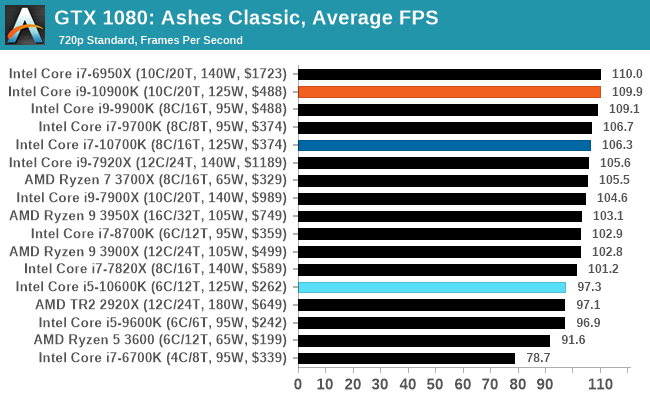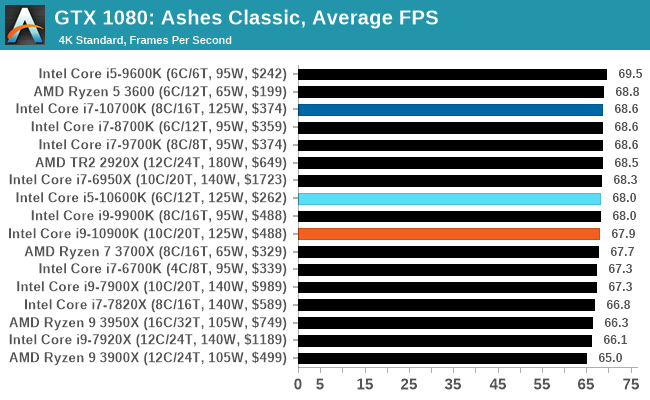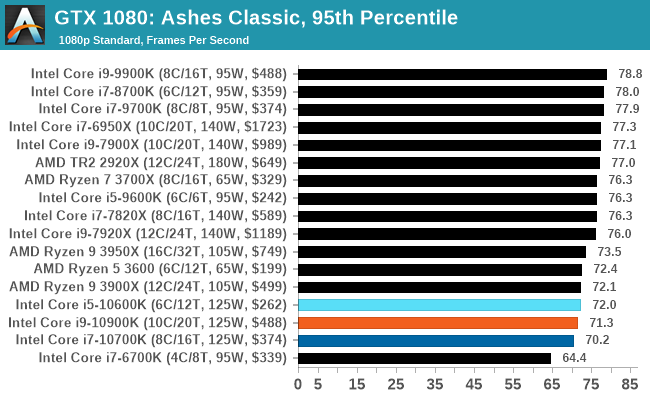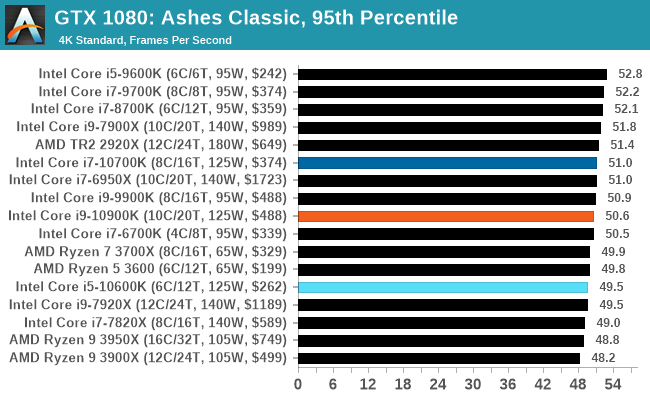The Intel Comet Lake Core i9-10900K, i7-10700K, i5-10600K CPU Review: Skylake We Go Again
by Dr. Ian Cutress on May 20, 2020 9:00 AM EST- Posted in
- CPUs
- Intel
- Skylake
- 14nm
- Z490
- 10th Gen Core
- Comet Lake
Gaming: Ashes Classic (DX12)
Seen as the holy child of DirectX12, Ashes of the Singularity (AoTS, or just Ashes) has been the first title to actively go explore as many of the DirectX12 features as it possibly can. Stardock, the developer behind the Nitrous engine which powers the game, has ensured that the real-time strategy title takes advantage of multiple cores and multiple graphics cards, in as many configurations as possible.
As a real-time strategy title, Ashes is all about responsiveness during both wide open shots but also concentrated battles. With DirectX12 at the helm, the ability to implement more draw calls per second allows the engine to work with substantial unit depth and effects that other RTS titles had to rely on combined draw calls to achieve, making some combined unit structures ultimately very rigid.
Stardock clearly understand the importance of an in-game benchmark, ensuring that such a tool was available and capable from day one, especially with all the additional DX12 features used and being able to characterize how they affected the title for the developer was important. The in-game benchmark performs a four minute fixed seed battle environment with a variety of shots, and outputs a vast amount of data to analyze.
For our benchmark, we run Ashes Classic: an older version of the game before the Escalation update. The reason for this is that this is easier to automate, without a splash screen, but still has a strong visual fidelity to test.
Ashes has dropdown options for MSAA, Light Quality, Object Quality, Shading Samples, Shadow Quality, Textures, and separate options for the terrain. There are several presents, from Very Low to Extreme: we run our benchmarks at the above settings, and take the frame-time output for our average and percentile numbers.
All of our benchmark results can also be found in our benchmark engine, Bench.

| AnandTech | IGP | Low | Medium | High |
| Average FPS |  |
 |
 |
 |
| 95th Percentile |  |
 |
 |
 |











220 Comments
View All Comments
schujj07 - Wednesday, May 20, 2020 - link
That doesn't make any sense. The Crysis CPU render is new as of the Ryzen 3300X review from 2 WEEKS ago. https://www.anandtech.com/show/15774/the-amd-ryzen...catavalon21 - Wednesday, May 20, 2020 - link
AMD is shown leading in many CPU tests dollar for dollar or watt for watt.Achaios - Wednesday, May 20, 2020 - link
Chipzilla, due to its greed, got us back to the Heat Output of 2008 processors such as the Yorkfield QX 9650.Lookup "Overclocking Intel's New 45nm QX9650: The Rules Have Changed" by Anandtech, and check the thermal output of the QX 9650.
I don't see why any enthusiast would buy these overpriced and bad cpus. I certainly won't.
t.s - Wednesday, May 20, 2020 - link
Never underestimate intel fanboys. This statement is copied from fb comment section about Ryzen 4000 will have 20% IPC uplift rumour:"AMD is made for applications like streaming. Intel is made for the other 90% of the market that relies on the single core performance. Yes, most of the industry still relies on Single core performance. Maybe know your industry before making a comment"
tipoo - Wednesday, May 20, 2020 - link
TIL I'm a streamer. I didn't think data science was all that interesting!Cooe - Wednesday, May 20, 2020 - link
Seems Intel took a good hard look a the FX-9590 and was like... "Yup. Let's do that. It'll work for sure this time, I promise!"WaltC - Wednesday, May 20, 2020 - link
Bingo...;)plonk420 - Wednesday, May 20, 2020 - link
a) thanks for showing core to core latencies! b) so this doesn't have TSX?Calypto - Wednesday, May 20, 2020 - link
Why not throw in a Coffee Lake inter-core latency chart for comparison?Calypto - Wednesday, May 20, 2020 - link
ignore me I'm stupid